You can go far on a single Metrobus from LeDroit Park
How far can you go from LeDroit Park on a one-seat Metrobus or Metrorail ride? Pretty far, actually. The map above illustrates all the bus lines and metro lines that run through or near LeDroit Park. View an interactive version of the map.
Residents are fairly familiar with our Metrorail system, but may not know the far reach of the Metrobus network. From LeDroit Park you can board a single bus and go to 14th Street, Dupont Circle, Georgetown, Adams Morgan, Woodley Park, the National Cathedral, Union Station, H Street NE, Eastern Market, and Barracks Row and never worry about parking. There are also several buses that go downtown to destinations like Chinatown, the Archives, Metro Center, Farragut Square, Foggy Bottom, and the Kennedy Center.
Here’s a breakdown of routes by the destinations they serve.
West to Shaw, Logan Circle, Dupont Circle, and Georgetown
Board the G2 bus, which originates in LeDroit Park. You can also use this bus to carry heavy groceries from the Whole Foods on P Street or the Giant at 7th & O Streets.
West and north to U Street, Adams Morgan, Woodley Park, the National Cathedral, and Tenleytown
| Destination | 90,92,93 | 96 | X3 (rush) |
|---|---|---|---|
| Boarding point » | Florida Ave | Florida Ave., New Jersey Ave. |
Florida Ave |
| U Street | Yes | Yes | Yes |
| Adams Morgan | 90 & 93 | Yes | Yes |
| Woodley Park, National Cathedral, Tenleytown | Yes | Yes |
North to Petworth, Brightwood, and Silver Spring
Board the 70 bus or 79 express bus on Georgia Ave. For longer distances, board the 79 at Georgia and Florida Avenues (northbound). This bus makes fewer stops and doesn’t run on Sundays.
To Union Station, H Street NE, Capitol Hill, and east of the Anacostia
Ranked in relative order of speediness to the destination:
| Destination | 80 | 90,92,93 | 96 | X3 (rush) |
|---|---|---|---|---|
| Boarding point » | N. Capitol St. | Florida Ave. | Florida Ave, New Jersey Ave. |
Florida Ave |
| Union Station | 1 | 1 | ||
| H Street NE | 1 | 2 | ||
| Capitol Hill (the Capitol) | 2 | 1 | ||
| Capitol Hill (Eastern Market) | 1 | 2 | ||
| Capitol Hill (Barracks Row) | 1 | |||
| Capitol Heights | 1 | |||
| Historic Anacostia, Congress Heights | 1 |
To downtown
If you regularly ride Metro, you know the subway system occasionally breaks. If you’re looking for other routes to downtown or to other Metro lines, try these buses (ranked in relative order of speediness to the destination):
| Destination | G2 | G8 | 80 | 70,79 | 90,92,93 | 96 |
|---|---|---|---|---|---|---|
| Boarding point » | 3rd St, Elm St, V St | Rhode Is. Ave | N. Captiol St. | 7th St./Georgia Ave. | Florida Ave | Florida Ave, New Jersey Ave. |
| Foggy Bottom | 1 | |||||
| The Capitol | 2 | 1 | ||||
| Chinatown, Archives | 2 | 1 | ||||
| Dupont Circle | 1 | |||||
| Farragut Square | 1 | 2 | ||||
| McPherson Square | 1 | 2 | ||||
| Union Station | 1 | 1 |
See you on the bus!
Note: X3 runs along Florida Avenue, but only during rush hour. 79 is an express bus (it skips stops) that doesn’t run on Sunday.
Metro station names get a little more rational
WMATA decided to revise our iconic Metro map to include the Silver Line and account for slight changes in rush-hour service on the Orange and Blue Lines. The new design, pictured above, ameliorates one of the agency’s usability problems: name sprawl. The new map wisely rearranges several station names to move the less important parts of sprawling names onto smaller subtitles.
When the system was built, station names were originally designed to be short and represent geographic places. Due to politics, local boosterism, and unwise interference from local politicians, some names have exploded in length. The U Street station name, “U Street/African-American Civil War Memorial/Cardozo”, is often cited as the poster child of clunky name sprawl. It wasn’t supposed to be this way. U Street as a place has a history and regional recognition strong enough to stand on its own. The station was originally listed as “U Street”, but then “Cardozo” got tacked on. Worse yet, in 1999 the DC Council voted (and paid) to change the name from “U Street-Cardozo” to the ridiculously longwinded “U Street/African-Amer Civil War Memorial/Cardozo” in honor of the new memorial at the 10th Street entrance.
Since shortening a station name is fraught with political peril— imagine the accusations if you tried to remove “African-American Civil War Memorial” from U Street’s name— WMATA is simply rearranging long names to create primary names and subtitles. U Street isn’t the only station getting this much-needed reordering. Woodley Park (Zoo/Adams Morgan), Gallery Place (Chinatown), Mt. Vernon Square (7th St – Convention Center), and Archives (Navy Memorial – Penn Quarter) are among the other station names that will become less graphically imperious on the map.
Weekend Metro closure may bring unintended improvement
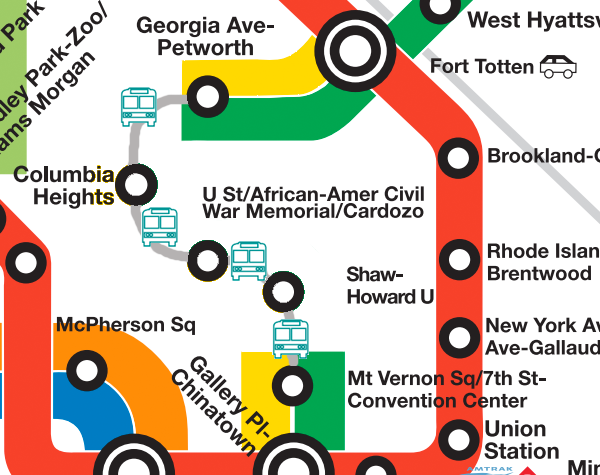
Temporarily closing a segment of the Green Line might ironically improve service for some this weekend. WMATA announced that it will close the Shaw, U Street, and Columbia Heights stations this weekend for scheduled track maintenance.
The stations will close at 10 pm Friday and won’t reopen until Tuesday morning’s normal opening time (Monday is a holiday). A similar closure will be in place on the Orange Line between East and West Falls Church stations as Metro works to connect the new Silver Line.
In the meantime, Metro will operate free shuttles along the route to ferry passengers through this service gap. Ironically, these shuttles may sometimes operate more frequently than the rail service would on a typical weekend.
Metro instituted a similar closure along a section of the Red Line on Labor Day weekend. On that weekend, we went to have brunch at a friend’s house in the Brookland neighborhood. During that time, Metro shuttles were running down his street every 2 minutes. Many of the buses were nearly empty, but for a moment we were jealous at the thought of transit service every 2 minutes.
Likewise, if WMATA keeps similarly short headways for the shuttles this weekend, the agency might actually enhance mobility between the Convention Center, Shaw, U Street, Columbia Heights, and Petworth.
One of Metro’s main shortcomings is that riding during non-rush periods, especially on weekends or at night, can entail waiting on platforms for as much as 24 minutes. This is an unacceptably low level of service, but our region lacks the political leadership to set a minimum level of transit service the way we do for utilities.
In DC, where 37% of households lack a car, the mayor and council chairman drive luxury cars at taxpayer expense, and other councilmembers receive free parking in front of the Wilson Building.
In the abstract, our leaders may appreciate the importance of frequent service, but nothing drives home the point like waiting on a Metro platform with 100 other people only to watch a packed train arrive half an hour later.
Though buses can’t match the speed and comfort of rail service, the frequency of bus shuttles this weekend might prove to be a significant, though temporary, transit improvement.
WMATA parcels for sale… again
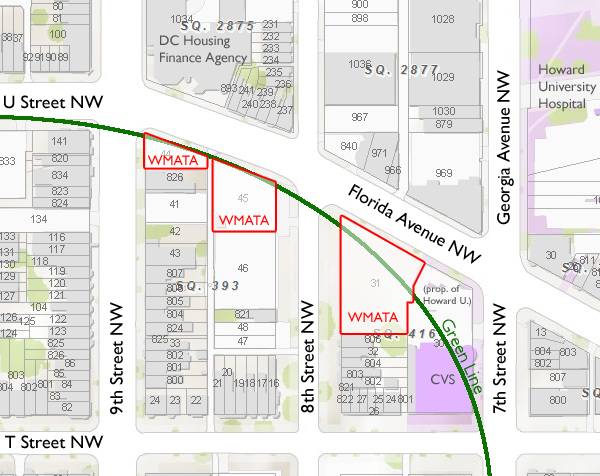
WMATA owns three vacant lots on the 700 and 800 blocks of Florida Avenue NW on the east end of the U Street corridor. The agency has just put the lots up for sale for the fourth time in 9 years. Judging by the brief sales window and by developer JBG’s previous hefty offer, we suspect the lots will be sold for a mixed-use development quite soon.
First let’s revisit this 9-year saga.
Act 1
The agency acquired the lots decades ago to build the Green Line and the lots have remained vacant, save for weekend flea markets, ever since. The agency first tried to sell the lots in 2002 and tentatively set a deal with Howard University in 2003. The university already owns the lot occupied by the CVS and its surface parking lot on 7th Street between Florida Avenue and T Street NW.
Act 2
Litigation brought that Howard deal to a halt and WMATA offered the lots again in 2007. Banneker Ventures LLC, infamous for its park contracts, won that round and aimed to lease the land for redevelopment into apartments and retail space.
Act 3
Then came the recession and the agency lost patience with Banneker’s inability to get financing for the deal. Last year the WMATA board voted to end its engagement with Banneker and put the lots out for bids yet again.
U Street land barron JBG offered WMATA $11.5 million, by far the highest offer, to buy the lots. The agency recently determined that in Act 3, none of the bids were “technically compliant” and so no sale could be completed.
Act 4
Now, nearly nine years after the agency first tried to dispose of the lots, WMATA is requesting sale offers again. These will be due May 2, leaving a 3-week window for offers. We assume (and hope) this fourth act is a formality so WMATA can properly sell the land to one of the third-round bidders.
* * *
Despite these delays, there is some good news as to what must go on these lots. WMATA’s RFP for the lots mandates a mixed-use development in compliance with the Office of Planning’s DUKE Plan:
WMATA parcels should be developed to include active, ground floor arts and retail with offices and residential above. Preference may be given to projects which include specialty restaurants, a small-format anchor and/or a cluster of retail shops, small clubs, and/or museum uses themed to the African American culture and experience of the district.
Furthermore, WMATA has requirements for design, too:
- Any building rising to the maximum permitted by-right height of 65 feet should provide a meaningful cornice at 65 feet. A one to one setback from the cornice should be provided for any building height above 65 feet (to a maximum of 90 feet) if requested through a planned unit development.
- Provide a minimum of 14’ ground level floor to finished ceiling clear height.
- Parking should be below grade. Please note that below grade parking will be limited by the presence of WMATA’s train tunnel directly below the Property
- All buildings are to be set directly on the front and side property lines.
The tops of the Green Line tunnels are about 30 feet below the surface, thus limiting the size of any underground garage. Since the lots are with within 900 feet of two metro stations, the parking demand for any project will be low.
WMATA’s requirements are good in that they mandate design features that create vibrant streets. Ground-floor retail (or cultural space) and the fact that the buildings will go up to the sidewalk are requirements that will enliven the sidewalk, especially at night. Prohibiting above-ground parking will prevent unsightly parking decks and will limit the ability for projects to induce car traffic.
We hope this last round will finally get these vacant lots into productive uses that enhance, rather than detract from, the area. With Progression Place and the Howard Theatre already in the works and with Howard Town Center just a few years off, these blocks are slated for some much-needed rejuvenation.
Opposing Metro Cuts
At Thursday’s monthly meeting of ANC1B, the commissioners voted unanimously to oppose various cuts to Metro service. In fact the level of opposition was so high that the commissioners tripped over each other adding amendments to oppose specific cuts to service. Specifically, the commission voted to
- Oppose all cuts to the Yellow Line all the way through Fort Totten (in Ward 5)
- Oppose ending service at midnight.
- Oppose closing the Tenth Street entrance to the U Street Metro station.
Noting the urgency of the cuts, the commission promised to formalize its opposition in a letter to WMATA the next day.
It’s reassuring to see that at least some local leaders recognize the important of Metro to life in the District.
Opposing Metro Service Cuts
Have you ever waited 30 minutes for a Metro train? That may become the norm on evenings if WMATA has its way. The transit agency is proposing to close a $40-million budget gap for the current fiscal year with a variety of measures, including the elimination of some jobs, the closure of certain mezzanines (including Shaw’s R Street entrance) at night, and by the reduction of call-center hours among other things. The worst part of the proposal, however, involves the reduction of train frequencies in the early mornings, late-nights and on weekends. One part of the proposal also calls for eliminating the eight-car trains that run on the Orange and Green Lines.
Many transit and urban planning bloggers around town have are warning of the “death spiral” that occurs when public agencies sharply reduce the quality and reach of their core services. Since reducing the frequency of trains reduces the intrinsic value of the transit system, the cuts risk driving away customers, thus ensuring a vicious cycle of ridership declines and subsequent revenue declines and service cuts.
The proposed frequency reductions mean that on Saturdays, Metro will actually run less often than the subway of Los Angeles. Los Angeles!
Our ANC Commissioner Myla Moss (ANC1B01 – LeDroit Park) emailed Councilmember Jim Graham (D – Ward 1) criticizing WMATA’s plan to close Shaw’s R Street entrance (the south entrance) late at night. Though we see how mezzanine closures will inconvenience a few riders by a few minutes at a few stations, we believe the real disservice is happening on the platforms: reducing train frequency will inconvenience all riders at every station.
Mr. Graham, we should remind you, is also the chairman of the WMATA board, which will hold a hearing and vote on the cuts on January 7. We have already emailed Mr. Graham to alert him to the dangers in some of the proposed cuts. We encourage you to let him know what you think.
Jim,
Can you imagine waiting 30 minutes for a Metro train to arrive? WMATA’s budget-cut proposal will leave many riders doing just that.
I’m worried that WMATA’s proposal to drastically cut rail and bus service is a terrible mistake that may lead to a “death spiral” in ridership and revenue. The proposed cuts to train and bus frequency will further turn off riders from the system, since reducing service makes the system intrinsically less valuable at a time when the District’s population is rising.
Your constituents in Ward One, a ward with some of the city’s highest population densities and lowest rates of car-ownership, will suffer greatly from reduced mobility options.
I urge you to vote against the proposal and request that WMATA management return with other options (e.g. fare increases, pay/benefit freezes, further staff reductions, entrance closings) that do not sacrifice the system’s core mission of providing decent mass-mobility.
Let us not follow the mistake of New York City, which, when faced with tax revenue shortfalls in the 1970s, reduced basic city services sharply. The reduction in services (park cleanings, street repairs, street sweepings, etc.) reduced the city’s attractiveness and further exacerbated the city’s financial woes— why stay in the city if the services are declining? Please do not let Metro (and DC, by extension) suffer a similar fate. Your constituents (and I am one of them) are heavily reliant on convenient and frequent transit service, which gives the District a competitive advantage over other cities and over the surrounding jurisdictions.
Eric Fidler
LeDroit ParkP.S. I am willing to pay a reasonable fare increase to avoid service cuts.
P.P.S. These proposed cuts will make trains less frequent than they are in Los Angeles, Boston, Philadelphia, Chicago, Montreal, Toronto, and New York. I can’t imagine a world in which even L.A. has better train service than Washington.
Let’s hope the board avoids these core-service reductions.

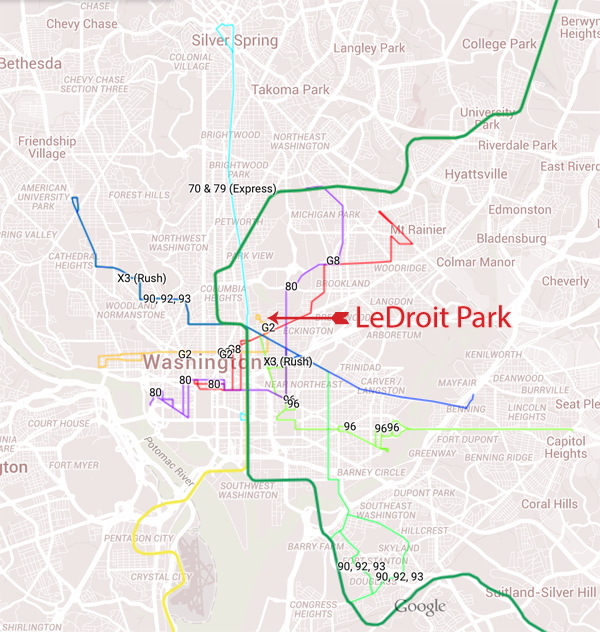
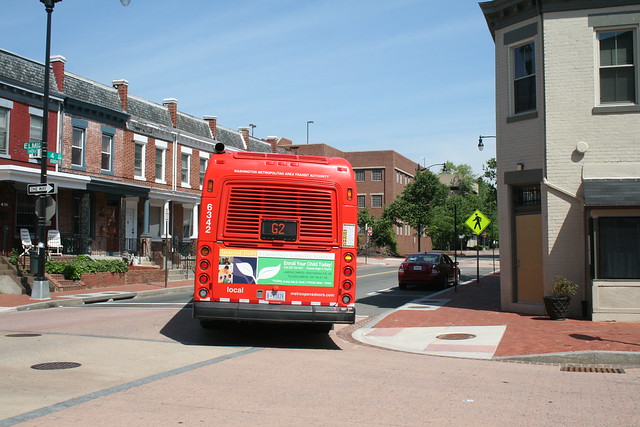
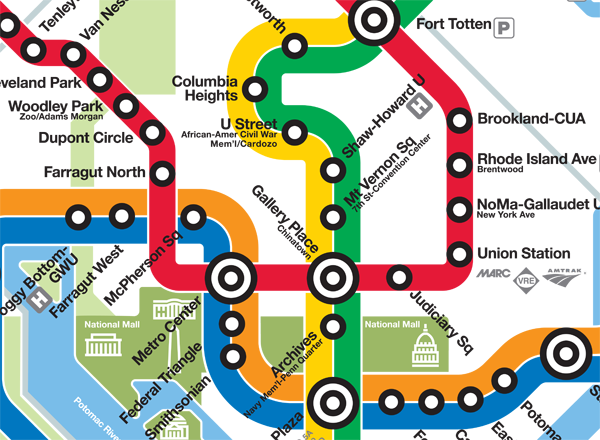
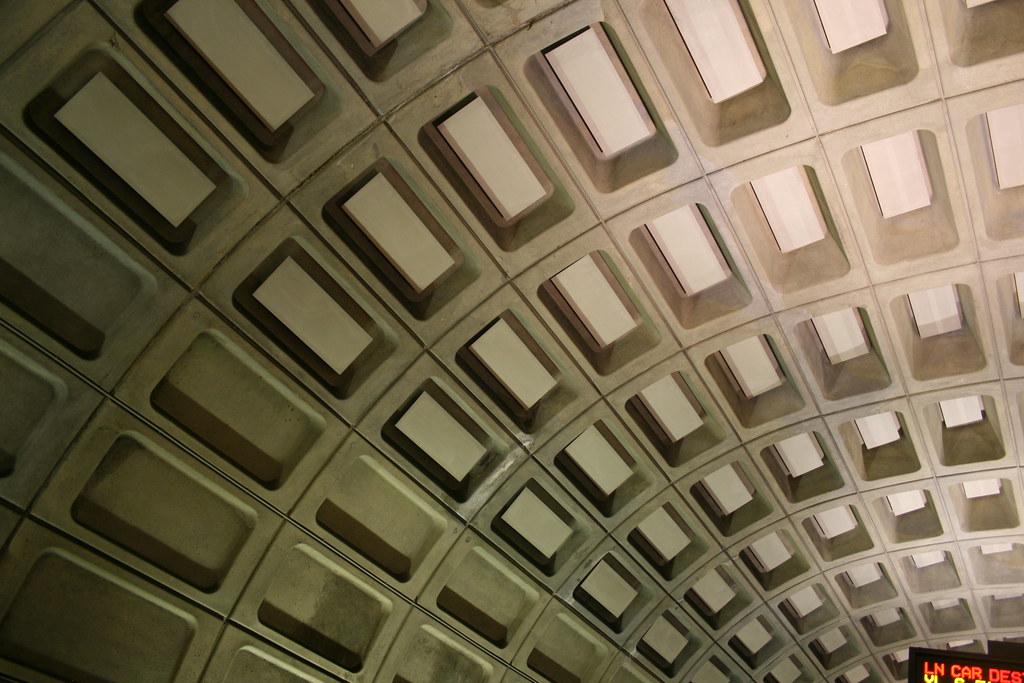
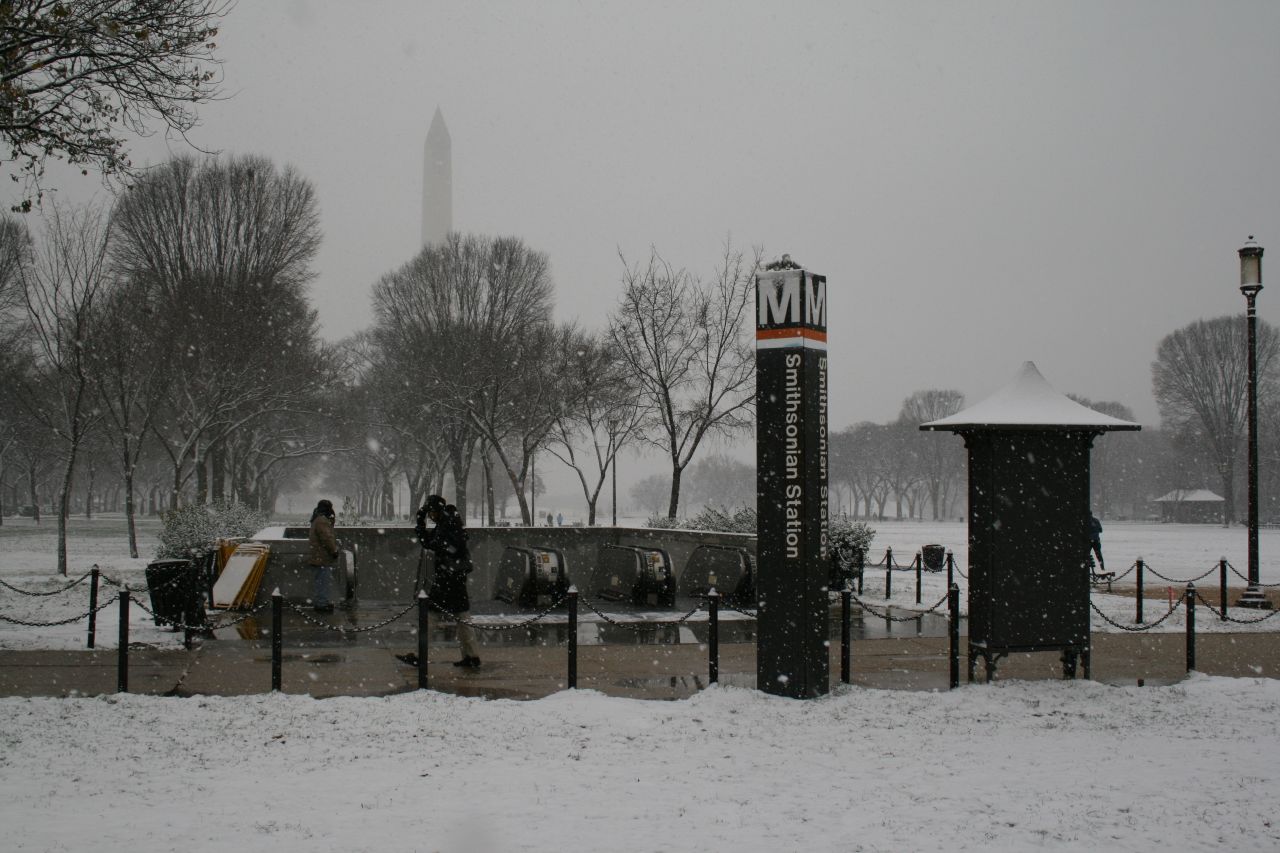






Recent Comments